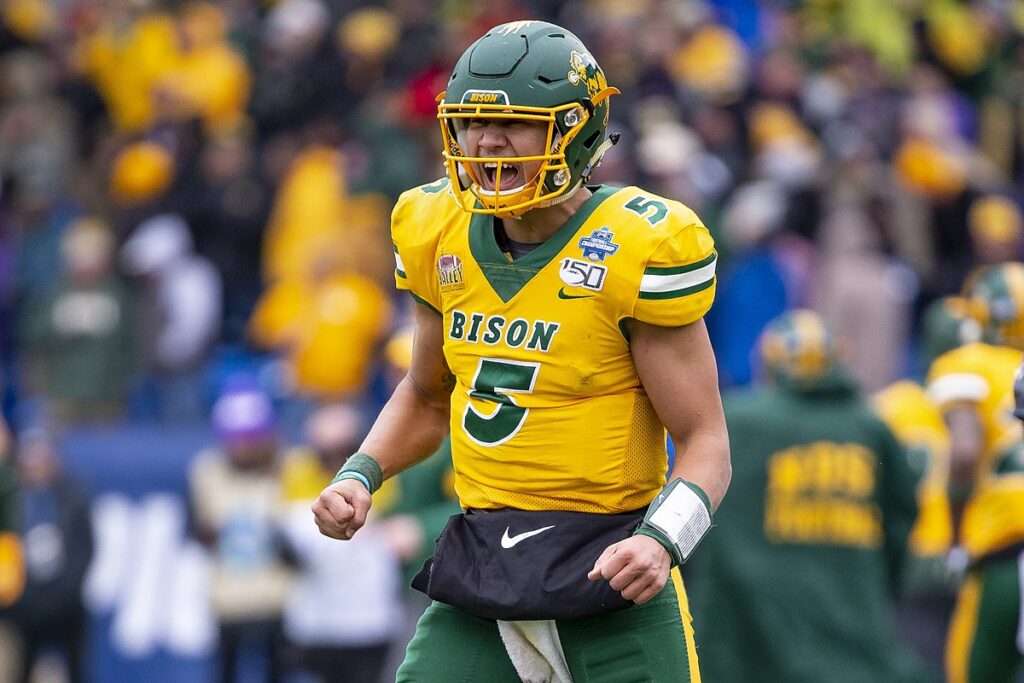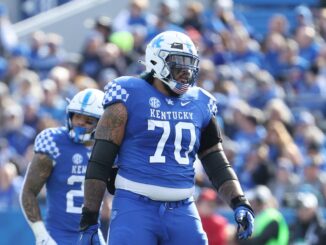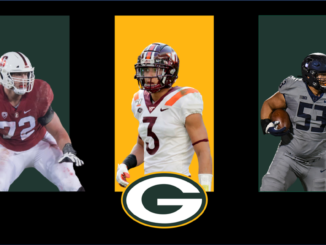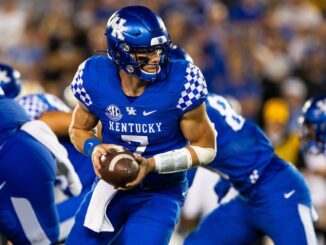The 2021 quarterback class may just be the best in a generation. Trevor Lawrence is the clear No. 1, but there are a number of other big names likely to go in the first round. We have only seen five quarterbacks go in the first round once since the turn of the millenium. We have also not seen three quarterbacks taken with the first three picks since 1999. Both of these things look set to change on April 29th.
1. Trevor Lawrence, Clemson

Pros: There is a reason why Lawrence is regarded as the best quarterback prospect in a generation. He already processes the game like an NFL veteran and is excellent at progressing through his reads and identifying optimal matchups. His average time to throw of just 2.35 seconds was by far the fastest of any draft-eligible quarterback. He has prototypical arm strength and the ability to throw with touch. His ability to sense and react to pressure is fantastic too and his pocket presence is amongst the best we have seen in recent years. Lawrence is also an excellent athlete and a legitimate threat as a runner in the open field. There are multiple reps on tape where he will outrun linebackers and he has averaged 6.7 yards per carry throughout his career. He is a tough runner too and has forced 39 missed tackles on his 142 career carries.
Cons: Lawrence is a rare talent but there are still some flaws to his game. He has a tendency to trust his arm too much and has a habit of forcing throws when nothing is really there. He was let off by a number of dropped interceptions in 2020 but he won’t be able to get away with this in the NFL. Whilst he reads the game well, there are some occasions where he fails to see a defender in coverage and throw it right to them. His deep ball accuracy can also be a little inconsistent and teams will want to see improvement in that regard.
Projection: 1st round (No. 1 overall)
2. Zach Wilson, BYU

Pros: Wilson is easily the most talented quarterback in this class when it comes to playing outside of structure. His ability to make throws on the move without setting his feet is exceptional and reminiscent of Patrick Mahomes. There are throws on Wilson’s tape that no other quarterback in this class could make. He combines all of this with elite accuracy at all levels of the field. His 80.3 per cent adjusted completion rate ranked fifth in the FBS this season and he racked up an astonishing 1,286 yards on passes of 20+ yards. His turnover worthy play rate of just 1.2 per cent ranked third in college football this season.
Cons: Wilson has a frustrating tendency to force throws downfield rather than taking easy yardage. This paid off at times but he will need to do a better job of taking what the defense gives him at the next level. Wilson also benefitted from playing behind an incredibly talented offensive line and did not face a tonne of pressure. There will be some concerns about how he will fare in a less-than-ideal situation in the NFL. The other obvious issue will be his sample size and level of competition. Wilson has only had one real season of elite production and none of these games were against Power Five teams.
Projection: 1st round (top five)
3. Justin Fields, Ohio State

Pros: Fields’ best trait is his accuracy. He had an 80.8 per cent adjusted completion rate this season, which ranked second to only Mac Jones. Fields has elite arm talent that will translate perfectly to the NFL and he is arguably the best deep ball thrower in this year’s class. He showcases a good understanding of ball placement and velocity and rarely puts the ball in harms way. Fields combines this arm talent with elite running ability, rivalling Trey Lance as the best in the class. He recently ran a 4.41 40-yard dash and combines this with the strength and power to be a threat in short yardage situations.
Cons: Fields ‘most notable weakness is his processing speed. He averaged a time to throw of 3.11 seconds this season, the third longest of any draft-eligible prospect. Part of this was the result of Ohio State’s offense and its reliance on long-developing routes, but Fields still has a tendency to hold on to the ball too long. He can struggle against disguised coverages and perhaps most worryingly he takes even longer to throw against the blitz. Fields also benefitted from a favourable offense that schemed open receivers and he had to make just 54 tight-window throw in his college career.
Projection: 1st round (top ten)
4. Trey Lance, North Dakota State

Pros: Lance has all other quarterbacks beaten when it comes to arm strength. He has tremendous velocity and can throw on a rope 30+ yards downfield. What makes him such an exciting prospect is that he pairs this elite arm strength with genuine ability as a runner. Lance is the best running quarterback in the 2021 class and can be used on designed runs, options, and scrambles. He looks more like a running back than a quarterback in the open field and has shades of Cam Newton to his game in this regard. Lance forced 40 missed tackles on 134 attempts in 2019 and averaged 6.9 yards per carry. He takes good care of the ball and had just one interception on 319 career attempts.
Cons: The biggest issue with Lance is his lack of experience. He has just one season as a starter and just 371 career dropbacks. For context, the top three quarterbacks in this class have all had over 750 dropbacks in college. He was also heavily protected by an NDSU offense that didn’t ask a lot from him as a passer. He averaged just 18 attempts per game in 2019 and would usually scramble if his first read wasn’t wide open. Accuracy is also a major concern and he had an adjusted completion percentage of just 51.1 on throws of 10+ yards in 2019. Lance has all of the tools to be an elite NFL quarterback, but he is still incredibly raw.
Projection: 1st round (top ten)
5. Mac Jones, Alabama

Pros: Jones’ performances in 2020 were legitimately impressive. He finished the season with 4,494 yards and 41 touchdowns with just four picks against an SEC-only schedule. Where he really excels is his accuracy and he doesn’t miss short and intermediate throws. Jones logged an adjusted completion percentage of 84.2 per cent, setting the college football record. This wasn’t a dink-and-dunk offense either and Jones had an average depth of target of 8.8 yards. From a technical standpoint he has all of the tools you want. His timing is excellent and he throws with anticipation. His pocket presence is good too and he isn’t phased by pressure.
Cons: The biggest knock on Jones’ game is his lack of athleticism and he offers very little outside of the pocket. He also lacks elite arm talent and there were a number of times on tape where he noticeably underthrew his receivers. There will also be questions about Jones’ favourable situation. He played behind the best offensive line in college football and was pressured on just 18.9 per cent of his dropbacks. He also played with two elite receiver prospects and had just 39 tight window throws this season. There will be questions about how translatable this experience is to the NFL.
Projection: 1st round
6. Davis Mills, Stanford

Pros: Mills is a former five-star recruit who was the No. 1 ranked pro-style quarterback in the 2017 recruiting class. This natural talent shows on tape and he is accurate at all levels of the field. His 78.8 per cent adjusted completion rate ranked fifth amongst draft-eligible quarterbacks in 2020. Despite a lack of starting experience, Mills is an excellent processor and is adept at making quick decisions. He has a quick release and his average time to throw of 2.42 seconds ranked second behind only Trevor Lawrence in the 2021 class. He also has the arm strength you want in a quarterback prospect.
Cons: His inexperience is notable and Mills has just 491 career dropbacks and 11 starts to his name. This shows on tape and there were far too many bad decisions. His 3.5 per cent turnover-worthy play rate in 2020 was the worst amongst quarterbacks on this list. He is also one of the more statuesque prospects you will find and offers nothing in terms of athleticism or mobility. Mills needs to be kept clean and have his feet set in order to deliver the ball consistently. This is concerning when combined with his below average pocket presence and Mills struggled when faced with pressure this season.
Projection: 3rd round
7. Kyle Trask, Florida

Pros: Despite being a high school backup and having just two years as a starter in college, Trask reads the game very well. His ability to recognise coverages and manipulate safeties with his eyes are at a level you would expect from a much more senior player. He really developed as a deep passer this season and led college football with 41 big-time throws. For context, the next best draft-eligible quarterback was Mac Jones with 32. He shows real toughness in the pocket and is able to stand in and deliver throws under pressure, although this can sometimes border on obliviousness.
Cons: Trask’s appeal at the next level will be limited by his lack of mobility and he doesn’t offer much outside of structure. His arm talent is sufficient but certainly nowhere near the levels of some other quarterbacks in this class. Perhaps the biggest concern is that as a traditional pocket passer he isn’t actually that accurate. His adjusted completion percentage on throws of less than 10 yards downfield ranked just 48th in the FBS this season. He benefitted heavily from having Kyle Pitts and Kadarius Toney to throw to and looked like a completely different player without them in the Bowl Game against Oklahoma.
Projection: 3rd round
8. Jamie Newman, Georgia

Pros: Newman possesses prototypical NFL arm strength and the ability to make throws at every level of the field. He plays with an attacking mentality too and 19.8 per cent of his passes in 2019 were 20+ yards downfield. He earned a 96.6 PFF grade on these throws, ranked second in the Power Five behind only Joe Burrow. Newman combines this arm talent with excellent mobility. He is a threat in the running game and Wake Forest used him on option plays and QB keepers. He showcases real toughness as a ball carrier, fighting for extra yardage and breaking tackles in the open field.
Cons: Newman’s decision to opt out of the 2020 season after his transfer to Georgia really hurt his stock. He also looked poor at the Senior Bowl and there will be questions about how well he can hold up against top competition. Teams will also have concerns about the translatability of Wake Forest’s offense. The scheme is heavily reliant on RPOs and go routes and as a result Newman was rarely asked to progress through his reads. His accuracy was also an issue at times and he never completed more than 61 per cent of his passes in a college season.
Projection: 4th round
9. Kellen Mond, Texas A&M

Pros: Mond was a four-year starter with the Aggies and is one of the most experienced quarterbacks in this year’s draft class. His decision making is pretty good and he is comfortable working through his progressions. He also adds value as a runner and has the athletic ability to be a threat in the open field. A real positive to his game is his willingness to keep his eyes downfield when outside of the pocket, always looking to pass before tucking and running. Mond is also one of the best quarterbacks at avoiding sacks. His 8.6 per cent pressure-to-sack rate in 2020 was by far the best amongst draft-eligible quarterbacks
Cons: Whilst hopes have often been high for Mond, he never really took the next step that many were expecting. His accuracy is average at best and his 70.8 per cent adjusted completion rate ranked 80th in college football this season. Whilst he did a good job of taking care of the ball, Mond rarely made plays downfield and his big-time throw rate of 3.8 per cent ranked just 96th. He can struggle under pressure and his lack of arm strength limits his ability to test opposing defenses.
Projection: 4th round
10. Shane Buechele, SMU

Pros: Buechele is an old-school gunslinger who loves to make big plays downfield. His 19 big-time throws ranked sixth amongst draft-eligible quarterbacks. He is also consistently accurate in the short areas, with an 84.3 per cent adjusted completion rate on throws of less than 10 yards downfield. Buechele even managed to put up good numbers despite persistent drop issues with his receivers. 11.4 per cent of his on-target passes were dropped in 2020, more than any other draft-eligible quarterback.
Cons: Whilst Buechele is accurate in the short areas, the same cannot be said for his downfield passing. He likes to air the ball out but average arm strength and inconsistent placement limit his effectiveness. He also lacks the mobility that you ideally want in a modern NFL quarterback and won’t be any sort of threat as a runner. His throwing motion definitely needs some work and he has a notably long release. There will also be concerns about the competition level he faced in the AAC and how translatable SMU’s Air Raid offense is to the NFL.
Projection: 6th round


